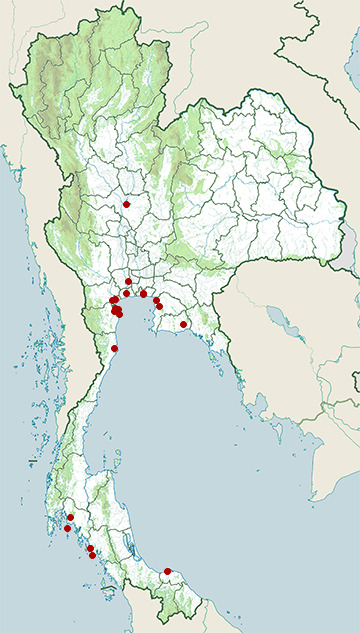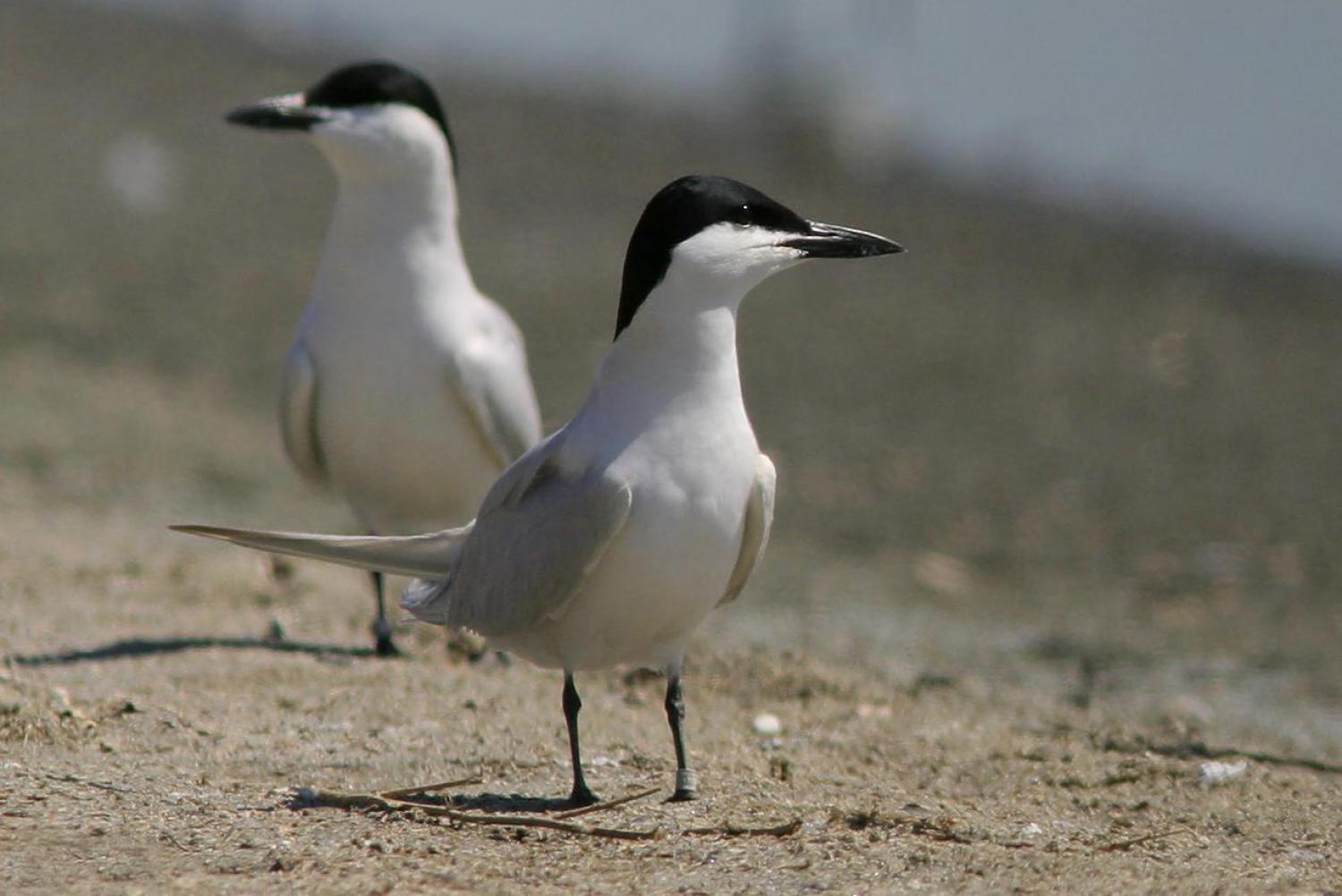Species of Thailand
Gull-billed tern
Gelochelidon nilotica
Johann Friedrich Gmelin, 1789
In Thai: นกนางนวลแกลบปากหนา
The gull-billed tern (Gelochelidon nilotica), formerly Sterna nilotica, is a tern in the family Laridae. The genus name is from Ancient Greek gelao, "to laugh", and khelidon, "swallow". The specific niloticus is from Latin and means of the Nile. The Australian gull-billed tern was previously considered a subspecies.
Description
This is a fairly large and powerful tern, similar in size and general appearance to a Sandwich tern, but the short thick gull-like bill, broad wings, long legs and robust body are distinctive. The summer adult has grey upperparts, white underparts, a black cap, strong black bill and black legs. The call is a characteristic ker-wik. It is 33 - 42 cm in length and 76 - 91 cm in wingspan. Body mass ranges from 150 - 292 g.
In winter, the cap is lost, and there is a dark patch through the eye like a Forster's tern or a Mediterranean gull. Juvenile gull-billed terns have a fainter mask, but otherwise look much like winter adults.
Juvenile Sandwich terns have a short bill, and are frequently mistaken for gull-billed tern where the latter species is uncommon, such as North Sea coasts.
Subspecies
There are five listed subspecies of the gull-billed tern:
- G. n. nilotica – (Gmelin, 1789): nominate, found in Europe, North Africa through the Middle East & south-central Asia to western China & Thailand
- G. n. affinis – (Horsfield, 1821): found in Transbaikalia to Manchuria, Japan, south and east China through southeast Asia to the Philippines, Borneo, Sulawesi & Sumatra
- G. n. aranea – (Wilson, 1814): found in eastern & southern United States, Greater Antilles
- G. n. vanrossemi – Bancroft, 1929: found from southern California to northwestern Mexico
- G. n. gronvoldi – Mathews, 1912: found from French Guiana to northeastern Argentina
Range
It breeds in warmer parts of the world in southern Europe, temperate and eastern Asia, both coasts of North America, eastern South America. This bird has a number of geographical races, differing mainly in size and minor plumage details.
All forms show a post-breeding dispersal, but the northern breeders are most migratory, wintering south to Africa, the Caribbean and northern South America, southern Asia and New Zealand.
The gull-billed tern is one of the species to which the Agreement on the Conservation of African-Eurasian Migratory Waterbirds (AEWA) applies.
Life history
This species breeds in colonies on lakes, marshes and coasts. It nests in a ground scrape and lays two to five eggs. While widely distributed in freshwater areas in Eurasia, it is associated almost solely with saltwater, coastal areas in North America.
This is a somewhat atypical tern, in appearance like a Sterna tern, but with feeding habits more like the Chlidonias marsh terns, black tern and white-winged tern. It used to be grouped in the genus Sterna but is now placed on its own in the genus Gelochelidon.
The gull-billed tern does not normally plunge dive for fish like the other white terns, and has a broader diet than most other terns. It largely feeds on insects taken in flight, and also often hunts over wet fields and even in brushy areas, to take amphibians and small mammals. It is also an opportunistic feeder, and has been observed to pick up and feed on dead dragonflies from the road.
This article uses material from Wikipedia released under the Creative Commons Attribution-Share-Alike Licence 3.0. Eventual photos shown in this page may or may not be from Wikipedia, please see the license details for photos in photo by-lines.
Category / Seasonal Status
Wiki listed status (concerning Thai population): Winter visitor
BCST Category: Recorded in an apparently wild state within the last 50 years
BCST Seasonal status: Non-breeding visitor
Scientific classification
- Kingdom
- Animalia
- Phylum
- Chordata
- Class
- Aves
- Order
- Charadriiformes
- Family
- Laridae
- Genus
- Gelochelidon
- Species
- Gelochelidon nilotica
Common names
- Thai: นกนางนวลแกลบปากหนา
Subspecies
Gelochelidon nilotica affinis, Thomas Horsfield, 1821
Range: Japan, south and east China through southeast Asia to the Philippines, Borneo, Sulawesi & Sumatra
Gelochelidon nilotica aranea, Alexander Wilson, 1814
Range: Eastern & southern USA, Greater Antilles
Gelochelidon nilotica gronvoldi, Gregory Macalister Mathews, 1912
Range: French Guiana to northeastern Argentina
Gelochelidon nilotica macrotarsa, John Gould, 1837
Range: Australia
Gelochelidon nilotica nilotica, Johann Friedrich Gmelin, 1789
Range: Europe, North Africa though the Middle East & south-central Asia to western China & Thailand
Gelochelidon nilotica vanrossemi, G. Bancroft, 1929
Range: Southern California to northwestern Mexico
Conservation status

Least Concern (IUCN3.1)
Photos
Please help us review the bird photos if wrong ones are used. We can be reached via our contact us page.
Range Map

- Amphawa District, Samut Songkhram
- Ban Laem District, Phetchaburi
- Bang Pu Recreation Centre
- Bueng Boraped Non-Hunting Area
- Hat Chao Mai National Park
- Khao Khiao - Khao Chomphu Wildlife Sanctuary
- Khao Sam Roi Yot National Park
- Klaeng District, Rayong
- Ko Libong
- Laem Pak Bia
- Mueang Chonburi District, Chonburi
- Mueang Krabi District, Krabi
- Mueang Pattani District, Pattani
- Mueang Phetchaburi District, Phetchaburi
- Mueang Samut Sakhon District, Samut Sakhon
- Mueang Samut Songkhram District, Samut Songkhram
- Pak Thale
- Phi Phi Islands
- Phutthamonthon District, Nakhon Pathom
- Samut Prakan Province

